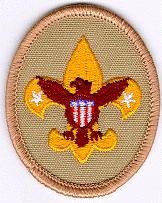 Demonstrate how to display, raise, lower and fold
the American flag.
Demonstrate how to display, raise, lower and fold
the American flag.
The
United States flag should always be treated with respect. It should never
come in contact with the ground. It can be flown daily, regardless of weather
conditions. It is usually flown from dawn until dusk.
The
flag can be carried on a staff with no other flag above it. If it is carried
in a parade, it is flown either higher and in front of other flags or in the
right hand column. If there is no flag to its left, a member of the honor
guard should march on the left.
If
it is displayed with flags on poles of different heights, it must be flown
high than the other flags.
When
it is displayed next to a speaker, it is always on the speakerís right.
If
it is displayed against a wall, the blue field should be in the upper right
hand corner.
When
flown over a street, the blue field should be to the north on an east-west
street, or to the east on a north-south street.
To
hoist the flag, one scout should attach it to the halyard, and another scout
should raise it quickly. When it clears the arms of the person who attached
it, that person should step back and salute.
To lower the flag one scout should lower it slowly, while the other salutes.
When it is in reach, the scout who was saluting should release it from the
halyard. The flag is then folded in half lengthwise and then in half lengthwise
again, with the blue field to the outside. While on scout holds the end with
the blue field, the other makes triangular folds until there is only the blue
field showing.
If
there is more than one flag being flown, the United States flag should be
raised first, and lowered last.
During
times of National disaster or mourning, the flag may be flown at half-staff.
To do this, the flag is raised briskly to the top, and after a brief pause,
lower to half-staff. At dusk, the flag is raised to the top, and after a brief
pause, lowered to the bottom.
The
flag is never flown upside-down, unless it is used as a distress signal.